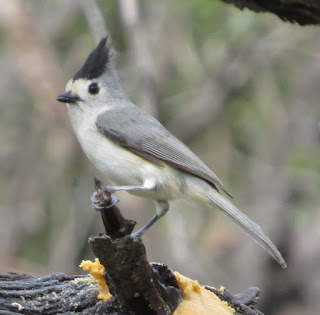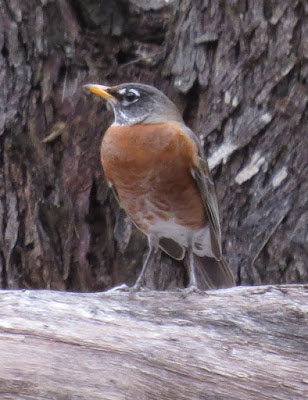Lydia
and David were from Houston and had won a three night stay at the Inn through a
silent auction with the Bluebird Society, so they wanted to use it before it
expired! J They had never been to South Texas before,
but many of our more widespread wintering (and
resident) species were also new for them!
They had a list compiled by a friend of theirs in Houston who ran local
trips, so based on that (and what could be expected in a day and a half), I had
planned on taking them to Starr County today and Estero Llano Grande the next
morning, but the continuing Hook-billed Kites demanded a detour from The Plan,
so after stopping at McDonald’s for a Sausage and Egg Biscuit, we were on our
way to the now famous levee!
Once
we got on the “canal road” next to the levee, we stopped short for Lydia’s
first Kiskadee in the canal vegetation, but what was also there were six
Groove-billed Anis! So we enjoyed them
for a bit before parking and joining the rest of the mob, and were greeted
with, “You missed him by three minutes!” L Not to be discouraged, my charges were
willing to wait and see if the bird returned (it was a gorgeous, windless day,
unlike last time), and in the meantime a young Red-shouldered Hawk perched in
the “kite tree”, and several unseen little things vocalized from the brush,
including Marsh Wren and Yellowthroat behind us and Long-billed Thrasher and
Lincoln’s Sparrow in front of us.
Thankfully we didn’t have to wait long before a big, fat, slaty-colored
raptor suddenly flew over the thornscrub heading east – it was the Hook-billed
Kite, bright white eyes and all! High
fives all around!
Groove-billed Ani, usually rare in the winter
Looking a little fluffy...
Birders hoping the kite will return (David and Lydia are in the further bunch...)
Interloping young Red-shouldered Hawk
He
had circled around and seemed to go down behind the Border Patrol corrals, so
we made plans to head back out the way we had come and head west on Old
Military Highway (OMH) so we’d have the sun to our backs, but not before
getting great looks at the resident Black Phoebe pair and a very cooperative
Lincoln’s Sparrow! We were putting our
gear away when I heard a splat, which
sent us back to the bridge looking for the Green Kingfisher that had just
vocalized, but he was either hidden or long gone (and the very distant Ringed Kingfisher rat-a-tatting counted for the day
list but that was it). Crawling down the
road next to the Butterfly Center bagged us a calling Couch’s Kingbird, and
while I was trying to spot it found a Blue-headed Vireo in a tree that
unfortunately my charges missed… Some
pretty Savannah Sparrows posed on the fence wires along OMH, but there was no
sign of the kite. We did spot a young Gray Hawk where that
canal road dumps onto OMH; he gave great
looks on his tree!
Black Phoebe
Lincoln's Sparrow
Young Gray Hawk
Planning
on using the restrooms at Bentsen, we pulled into the parking lot where once
again a mob of “accidental” House Finches were feeding in the grass along with
several American Goldfinches! (A look at
the TOS Handbook will show you that House Finches theoretically don’t occur
here, but they’re gradually becoming more established…) And while editing the pictures later I discovered that some Pine Siskins, also "flaggable" by eBird in the Valley, were in amongst them! I made another command decision to spend time
at the Gatehouse Feeders since we were there (and Chachalacas weren’t
necessarily a given at Salineño). I was
also hoping for kingfishers along the canal, but they weren’t playing
ball… However, the chachalacas at the
feeders made up for it; Lydia was amazed at how tame they were! We also enjoyed Green Jays, a Long-billed
Thrasher, and a White-tipped Dove while watching the antics of the “big
boys”! On the way out we ran into John
Kaye (the Bentsen Hawk Watch Guy) who was leading a group, and at the canal we
caught sight of an immature hawk that everyone mused could have been the Broad-winged Hawk that was hanging around! I got the scope on it, and realized
(especially after comparing juvie Broad-winged with Red-shouldered on the handy
dandy Sibley app) I’d be hard-pressed to tell the two apart unless I could see the
tell-tale checkerboard pattern on the secondaries that a Red-shouldered shows
(which I couldn’t see, of course)! A
second bird appeared that was a more finely streaked Redshoulder (and proved it
when he flew and showed the pale crescents in his wings), so when I saw a
utility truck go down the side road that would probably flush the problem hawk,
I started a video and followed the bird when he did fly. Once home I could
analyze the video frame by frame, and thankfully it caught the same buffy
crescents that nailed it as a Redshoulder.
John’s gang also found a Sharp-shinned Hawk that darted into a tree, and
we all had a heckuva time trying to refind it!
House Finch (above and below), considered rare in the Valley (at least at present)!
Three Pine Siskins feed behind an American Goldfinch
Lydia points something out to Dave at the canal
Checking out the "Gatehouse Feeders"
Mob of Chachalacas
Dave and friends...
Another young Red-shouldered Hawk
Headed
upriver after that, stopping at the Whataburger in Rio Grande City for lunch
(“cutting back” has been shot to heck this week L). Once in Salineño Lydia was even happy to see
Collared Doves! J We
went to the boat ramp first, picking up a couple of Neotropic Cormorants on the
river, an Osprey eating lunch, and hearing this horrendous roaring on the other
side (we were guessing wild boars but then saw a bovine over there and
concluded it could have been a bull…), then hiking the “Seedeater Trail” in
hopes of bagging said seedeaters. They
didn’t show (not surprisingly), but we heard an Audubon’s Oriole calling on the
Island and had a nice pair of Couch’s Kingbirds at trail’s end. Other than that we just had the regular
wintering stuff (gnatcatchers, kinglets, et al) along the trail.
Osprey with breakfast
We
then spent a very relaxing hour at the feeders, where Lydia spotted an Olive
Sparrow coming in to the water feature right away! Long-billed Thrashers were particularly
cooperative, and we enjoyed all the regular players: Green Jays, Kiskadees, Altamira Orioles,
titmice, and Cardinals. The female
Hooded Oriole showed off regularly, but the Audubon’s only came in briefly and
gave obscured views. We always get
American Goldfinches every winter, but this year they’ve literally invaded and
have been everywhere in numbers, and here was no exception! A Lincoln’s Sparrow did the “Towhee Shuffle”
under the bushes, and a White-tipped Dove made a very brief appearance in the
back. Both the woodpeckers came in, and
I was very happy that the guys got a fabulous look at the male Golden-fronted,
as that was one Lydia really wanted to see well!
An Altamira Oriole competes with the House Sparrows over the PB mixture!
Readying for the attack...
More Altamira shots
Long-billed Thrasher
American Goldfinch
Green Jay (check out the eyebrows!)
Golden-fronted Woodpecker (female above, male below)
Black-crested Titmouse
Everyone signs in with Mike!
On
the way up there we noticed that the construction traffic going the other way
in La Joya was horrendous, so we decided to leave a little early and take
Sparrow Road up and around (and out-of-the-way but more scenic route). But we didn’t get far from the feeder parking
area when three Gray Hawks whistled and circled overhead! A Bewick’s Wren was also singing, but we
couldn’t get him to come out… We went
ahead and made a quick run up the Dump Road, getting a brief view of a
Curve-billed Thrasher before reaching the dirt portion, and finding a couple of
Lark Sparrows in with some Mourning Doves!
A pair of Harris’ Hawks was on the old windmill, and we heard a
chattering Pyrrhuloxia, but he didn’t wanna come out, either… L
Harris' Hawk pair on the old windmill
Headed
back about then, and took Sparrow Road as planned. While enjoying the scenery, we blasted by a
magnificent White-tailed Hawk in a dead tree, so we wheeled around to get
fabulous looks! As we headed east on
what eventually turned into SR 101, it dawned on me that we could go home by
way of Trenton and maybe catch the Green Parakeet Show! Sounded good, so that’s exactly what we did;
when we got there, we were a bit early, but eventually the big flocks started
screeching overhead and a few decided to start filling up the power lines! It wasn’t the spectacle you get at sunset,
but we got great scope looks and my charges were happy, so we headed on home
with a modest 61 species for the day.
Bird list:
Plain
Chachalaca
Rock
Pigeon (Feral Pigeon) Eurasian Collared-Dove
White-tipped Dove
White-winged Dove
Mourning Dove
Groove-billed Ani
Neotropic Cormorant
Cattle Egret
Black Vulture
Turkey Vulture
Osprey
Hook-billed Kite
Sharp-shinned Hawk
Harris's Hawk
White-tailed Hawk
Gray Hawk
Red-shouldered Hawk
Red-tailed Hawk
Ringed Kingfisher
Green Kingfisher
Golden-fronted Woodpecker
Ladder-backed Woodpecker
Crested Caracara
American Kestrel
Black Phoebe
Eastern Phoebe
Great Kiskadee
Couch's Kingbird
Loggerhead Shrike
White-eyed Vireo
Blue-headed Vireo
Green Jay
Black-crested Titmouse
Verdin
House Wren
Marsh Wren
Bewick's Wren
Blue-gray Gnatcatcher
Ruby-crowned Kinglet
Curve-billed Thrasher
Long-billed Thrasher
Northern Mockingbird
European Starling
House Finch
American Goldfinch
Pine Siskin
Olive Sparrow
Lark Sparrow
Savannah Sparrow
Lincoln's Sparrow
Altamira Oriole
Audubon's Oriole
Red-winged Blackbird
Great-tailed Grackle
Orange-crowned Warbler
Common Yellowthroat
Yellow-rumped Warbler
Northern Cardinal
Pyrrhuloxia
House Sparrow






















































